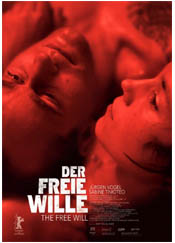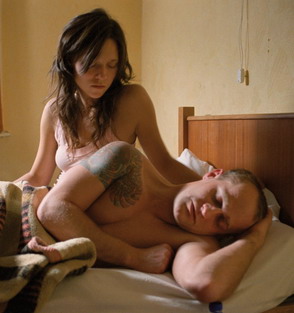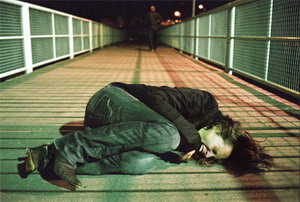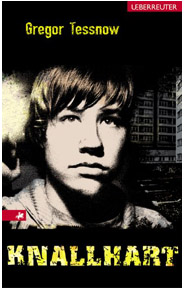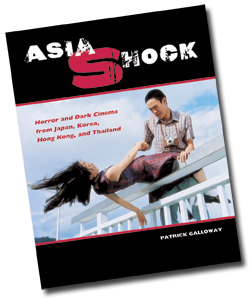
Patrick Galloway appeared at Codys-Stockton downtown San Francisco to promote the Stonebridge publication of
Asia Shock: Horror and Dark Cinema From Japan, Korea, Hong Kong, and Thailand. In one of the best-mounted book readings I have ever experienced, Patrick utilized a laptop and Apple's Front Row software to talk about Asian films by—imagine!—showing his audience Asian film clips! Though he was sweating bullets at first because the technology was betraying him, an attorney wandering through the bookstore overheard his consternation and stepped in to rescue the day. As Joe Campbell has written all over the place, a hero has allies he doesn't even know he has!
Patrick started out by telling us a little bit about himself. He grew up in San Francisco and got his B.A. at San Francisco State in English Literature. In the late '90s he worked in the dot.com boom and then—when it went dot.bomb in 2001—he went through some "changes" and decided to focus on his writing. His first book was
Stray Dogs & Lone Wolves: The Samurai Film Handbook, also published by Stonebridge.
Assuming that someone might wonder why a person caught up in sword films would likewise be interested in bizarre, extreme Asian cinema, Patrick read from the book's foreword by way of explanation: "Ever since I can remember I've loved the dead. Not literally, you understand, but conceptually. From an early age, my imagination and curiosity have run to the morbid, the depraved, to desperate acts with guns and knives, to people in the woods with plastic bags and shovels, to dark secrets behind the boathouse, to things unearthed that play havoc with the living—that sort of thing. As a teenager I read
The Exorcist,
The Omen,
The Amityville Horror, Poe, Lovecraft, and King, and I wrote my own twisted little tales. And, of course, horror films were a perennial pleasure. Years later, when I discovered Asian film, I found not only a lively tradition of macabre cinema (particularly in Japan), but one far more extreme and outrageous than anything I'd experienced before. Rivers of blood! Mountains of corpses! There seemed to be no limits placed on the Asian filmmaker's vision, no boundaries in terms of topic or depiction. Everything imaginable was on the chopping block, so to speak. How gratifying to find two things I loved, morbid tales and Asian cinema, coming together so beautifully. This book is an expression of my appreciation for the Asian films and filmmakers who opened my eyes to what horror is really all about." (2006:7)
Jumping to the tail end of his foreward, Patrick continued: "
Asia Shock represents a personal journey. It was not my intention to write an exhaustive discussion of Asian dark cinema and this is certainly no all-inclusive omnibus. My aim was to look at a lot of films and write about what I considered the standouts, films that had more to offer than just blood, films that explored the grotesque rather than the merely gross. It is my hope that I've come up with some good insights and shed some light—but not too much light. The darkness hates the light." (2006:8)
The theme of the book, Patrick stated, is that—when it comes to "dark cinema"—nobody does it darker than Asian filmmakers. The book grapples with
why that is, employing a little cultural anthropology; but, most notably, Patrick has watched a lot of movies to compare and contrast between Asian cinema and, say, Hollywood cinema. He read another section to define "dark cinema": "This book is an exploration of what I term 'dark cinema.' Dark cinema is a meta-genre that embraces the macabre and disturbing, shocking and profane, dire and devastating extremes of the contemporary film experience. Dark cinema encompasses the horror genre, but extends to exploitation film, black comedy, psychological thrillers, and police procedurals (the kind that investigate a string of abominable crimes), as well as certain types of art house fare. The common denominator? The darkness. In my scheme, darkness essentially equals death, and there's no escaping the cold shadow of that scythe-toting, bony-finger-beckoning cowled one—it extends over all the films on offer in
Asia Shock, a region of dark corners, nightmares, cruelty, insanity, imprisonment, murder, and revenge. There's also a good deal of gore, ghosts, curses, cannibalism, voodoo, disease, zombies, demons, necrophilia, rape, psychosis, all manner of torture, and bulging bin bags of body parts. Along the way you'll encounter human pork buns, a haunted cell phone, the odd corpse in a wall, a bit of tongue amputation, a cursed videotape, someone hung from hooks, and the occasional unpleasant medical experiment. Fasten your seat belts, folks." (2006:9)
Patrick joked that he arranged the eight chapters of his table of contents by basing them on phases of life. After the introductory chapter, there's "Family"—where you begin life in the questionable embrace of family—eventually entering "Society" at some point wherein you encounter frightening "Technology". Then things start to go really bad and you experience "Confinement" and "Psychosis", possibly even go through a bout of "Possession", and finally you go to "Hell". His audience laughed.
Structuring his reading so that he could show a film clip to represent each chapter and, thereby, work his way through the book, Patrick likewise chose clips representative of the different national cinemas: some Japanese films, some Korean films, a Hong Kong film and a Thai film. All in all, there are roughly 60 films reviewed in
Asia Shock, either fully or by sidebar.
Before screening the clips Patrick asked his audience if they had any questions or comments? If they wanted a mint?
His first clip was from Takashi Miike's
Fudoh: The Next Generation. Miike is a Japanese filmmaker who has quite a following and is one of the more extreme filmmakers you're ever going to experience.
Fudoh: The Next Generation is based on
manga, which is a Japanese comic, except that Japanese comics are very different from what we consider a comic book in our culture.
Manga covers every topic you can imagine, from fluffy bunnies to extreme gore and violence. If you want a shortcut into extreme Japanese cinema, Patrick suggested, look for a movie based on Japanese
manga.
This story concerns the
yakuza, basically the Japanese mafia, a 100-year-old organized crime syndicate and concerns a young fellow named Ricky Fudoh whose father is a
yakuza boss. Unbeknownst to Dad, Ricky's helping Dad out through his own gang of teenage assassins; in some cases little kid assassins. They're running around and knocking off all of Dad's enemies. In the proffered clip we follow the new kid in high school who's a very tall guy with long hair who's very tough and has been watching Ricky. He wants to know what Ricky Fudoh is up to because every time Ricky makes a phone call on his cell phone, somebody gets it. He confronts Ricky in the high school hallway and Ricky is defended by one of his teenage girl body guards. Just to prepare us, Patrick cautioned, she has multiple talents, namely shooting poisonous darts from a certain part of her anatomy. Enough said.
For the "Society" chapter Patrick shared a clip from Fruit Chan's
Dumplings. Chan made a short version and a full-length version of
Dumplings. Patrick has only seen the short version and that was enough for him.
Dumplings features the "lovely and talented" Bai Ling, the Chinese actress who has done some big budget films like
Wild, Wild West and
Star Wars III: Revenge of the Sith (and who I last saw dancing provocatively on a tabletop at the Kabuki Café during the S.F. International). But in this film Bai Ling speaks in her native Cantonese and plays a character named Aunt Mei who lives in a tenement in Hong Kong. She's kind of a witchy woman who has "powers." Her big product is she makes these fabulous special dumplings that middle-aged women come around and enjoy. They have wonderful, restorative power that make the women youthful and more attractive to their husbands and, in some cases, fertile. Unfortunately, the main ingredient of these dumplings is—you guessed it—human fetuses. Patrick's featured clip showed Aunt Mei going to her connection in a hospital in mainland China and then interacting with one of her female clients.
There was an actual incident that happened back in 1995 where a provincial hospital was caught distributing fetuses for nutritional purposes. This hospital was actually featured in
Dumplings. Patrick was quick to qualify that he didn't mean to imply that this was standard operational procedure in Chinese hospitals. It was just one isolated incident reported in the newspapers. Fruit Chan just wanted to run with the idea.
For the "Technology" chapter Patrick chose a clip from
Ringu. Confident that most of his audience knew the film—if not its original Japanese version, then the Hollywood remake with Naomi Watts—Patrick admitted that his experience with American remakes is that Hollywood invariably wrings out any unique qualities. All ambiguities are completely erased and completely S-P-E-L-L-E-D O-U-T and
Ringu and its American counterpart
The Ring are no exception. He writes about both versions in his book. His chosen clip featured
Hiroyuki Sanada, an excellent Japanese actor also featured in
The Last Sumurai where he kicks the living shit out of Tom Cruise with a wooden sword. In the '70s Sanada was in a lot of action martial arts films. He was a member of
Sonny Chiba's Japan Action Club, which was a group of stunt men and martial artists. But he turned his back on the action movies by age 25 to become a serious actor and did very well for himself.
Reminding his audience that the premise of
Ringu is that people get a haunted video tape that they watch only to die five days later, Patrick admitted the "kooky premise" nonetheless works. They get killed by an evil she-ghost named Sadako with long hair who was thrown down a well. So you get to see her often crawling out of a well, as in the clip.
Moving on to the "Confinement" chapter, Patrick chose a Korean clip from Park Chan-Wook's
Oldboy and encouraged his audience to get a hold of anything Park Chan-Wook has done, particularly
JSA (Joint Security Area), a tense political thriller which takes place on the border between North and South Korea. Of course, Park Chan-Wook is well-known for his "revenge trilogy"—
Sympathy For Mr. Vengeance,
Oldboy, and
Sympathy for Lady Vengeance. The star of
Oldboy is
Choi Min-sik who Patrick characterized as the Laurence Olivier of South Korea but then tweaked that characterization by adding on Robert DeNiro and Marlon Brando as well.
Oldboy is Min-sik's film and the impact of the film is largely due to his performance.
The film's premise is that a regular salary man is abducted and locked away in a private prison for 15 years with nothing but a t.v. to keep him company. One day he's—just as mysteriously—released on a rooftop of a building in Seoul not far from where he was abducted. Oldboy's objective is to figure out who did this to him and why and then to, of course, get his revenge. The guy who
did do this to him wants this too for some strange reason that unfolds throughout the movie. The scene Patrick elected to screen is when Oldboy wakes up on the top of the building. He hasn't seen another human being for 15 years. He's only had a t.v. for company and he sees another fellow on the roof (clutching a poodle) who appears ready to jump off.
Moving to the "Psychosis" chapter, Patrick offered another Korean clip from the film
Say Yes. It's a lesser-known title from Kim Sung-Hong featuring veteran actor
Park Joong-Hoon who's been around since the early '80s. Joong-Hoon is an interesting-looking guy. He's got an odd-shaped face. He used to do a lot of comedy but recently has transitioned into more serious roles and, Patrick quipped, it doesn't get more serious than the role in this film, which aligns neatly with the psycho hitchhiker genre. Joong-Hoon plays the psychotic hitchhiker who gets picked up by a young couple and proceeds to torment them through more and more heinous degrees. First he puts them through all kinds of changes, threatens their lives, and actually tries to kill them or seems like he's trying to kill them. He works the boyfriend and then allows himself in a public place to be severely beaten by the boyfriend but, of course, this is all part of his plan. Because then he places assault charges on the boyfriend to use that as leverage, saying, "Okay, I'll drop the charges if you let me travel with you." Okay? He wants to be the traveling companion of this young couple that he's already been tormenting. As you can imagine, the boyfriend isn't too keen on this arrangement but Joong-Hoon is insisting upon them all having dinner together to discuss it. This clip begins with the strange threesome arriving to dinner.
Even though that particular scene is fairly conventional for films of this sort, Patrick promises that
Say Yes ratchets up. Its tension and violence go off the scale and is almost hard to watch.
The "Possession" chapter is a short one, featuring only a few films; but, one of them is a Thai film called
Body Jumper, which refers to a ghost that can jump from one body to another. In this case the ghost is something called the "
Pob", which is a traditional ghost from Thai folklore. It's what you call a liver-hungry ghost. This is a ghost that, yes, eats your liver. What's great about Asian ghosts is that they're not these floating spectre-like ghosts; they're very real. They can kill you. That's what makes them far more vicious.
Body Jumper is actually a horror comedy and—though difficult to track down as Thai films frequently are—worth the effort.
In this story the basic premise is that there is a group of young college students who are all friends. They go off on a trip to the provinces. One of them, a pretty young girl named Ker, becomes possessed by a
Pob. A
Pob traditionally is an old crone with claws and a nasty thing—which it eventually becomes by the end of the film—but, for a lot of the film the
Pob is possessing a pretty girl named Ker and she just runs amok eating men's livers. Her friends gradually figure out what she's up to and, in the screened scene, they follow her to a disco where she's found her latest victim. She's going to eat his liver but she's going to try a different way of getting at it that she hasn't tried before.
The last chapter is the "Hell" chapter and Patrick felt there was no better clip to represent the chapter than one from a 1960 Japanese film called
Jigoku (or
Hell). Recently released by the
Criterion collection after being difficult to track down for many years,
Jigoku is a groundbreaking film in Japanese horror directed by Nobuo Nakagawa, who is often considered the Granddaddy of Japanese horror cinema. Nakagawa, however, was prolific and could do all kinds of genres. He worked in the '40s, '50s, '60s. Notwithstanding, he really had a way with the old scary stuff.
So, again, 1960. If you think about what was going on in even indie cinema in this country, probably the goriest thing you could come up with would be Herschell Gordon Lewis's
2000 Maniacs where you get a woman's arm chopped off by an axe. There is more crazy, wild violence and horrible humans in five minutes of
Jigoku, Patrick insists, than all of
2000 Maniacs.
Jigoku is an hour and 40 minutes long. The first hour you spend with the main character, a young college student, and a number of other characters who have all transgressed the laws of the universe and they're all going to go to Hell. They all go to Hell at the same time, in fact, which is an interesting point in the movie. The last 40 minutes of the film you spend in Hell watching these people get tormented. The main character Shiro is played by
Shigeru Amachi, a fine actor who was in a number of Nobuo Nakagawa films.
In this scene he's just learned that he has a baby daughter. His girlfriend's also in Hell and has told him he has a baby daughter. At the very beginning of the clip his daughter is floating down a river of blood on a green lotus. Then you see Shiro running around looking for her.
Noting the screams of the characters in
Jigoku, Patrick commented that—while writing his book on the samurai—he realized no one can scream like a Japanese actor or actress. He's never heard another group of people on the planet with such bloodcurdling screams.
To finish off his program Patrick offered a preview of the Korean horror blockbuster
The Host.
Cross-posted at
Twitch.
02/04/07 UPDATE: Pam Grady reports to
The Chronicle on
Asia Shock.
Wired's Chris Baker asks Patrick to share his Top 5 Most Deliciously Appalling Moments in Asian Shock Films.

